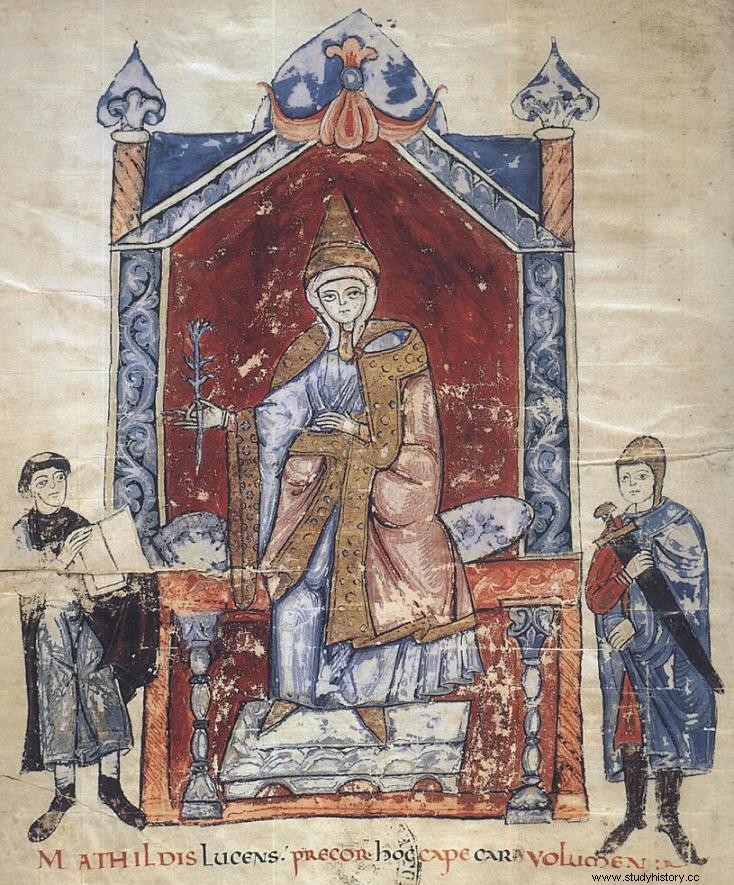Matilda of Tuscany (1046 – 1115) was an Italian princess who played a very important role during the Investiture Quarrel. She also remained famous for military feats.
Education and marriage negotiations
 The youngest child of Béatrice de Bar and Boniface III, Marquis of Tuscany, Mathilde is, through her mother, granddaughter of Frederick II, Duke of Lorraine. In 1052, her father was assassinated and the following year her older sister also died. To protect her children's inheritance, Béatrice then remarried Godefroid II of Ardenne, who had rebelled against Emperor Henry III, while Mathilde was promised to her son, Godefroid III of Ardenne.
The youngest child of Béatrice de Bar and Boniface III, Marquis of Tuscany, Mathilde is, through her mother, granddaughter of Frederick II, Duke of Lorraine. In 1052, her father was assassinated and the following year her older sister also died. To protect her children's inheritance, Béatrice then remarried Godefroid II of Ardenne, who had rebelled against Emperor Henry III, while Mathilde was promised to her son, Godefroid III of Ardenne.
Furious at this marriage, Henri III goes down to Italy and Béatrice, traveling with her son Frédéric, tries to meet him to explain herself. But Henri III imprisons them in harsh conditions and Frédéric dies in detention, making Mathilde the only heiress. In 1056, the emperor signed peace with Godefroid and, on Henry's death, Beatrice and her husband returned to Italy to Mathilde.
During her youth, Mathilde learned to speak and write several languages, including Latin, French and German. From her military tutor, she learned the arts of war. He teaches him in particular horse riding, the handling of the spear, the pike, the ax and the sword.
The Quarrel of Investitures
In 1071, Matilda of Tuscany married her brother-in-law, Godefroid III, for whom she felt nothing but contempt. The two spouses quickly live apart. In the same year, she is said to have given birth to a daughter, Beatrice, who may have died in her early years. In 1076, Béatrice de Bar and Godefroid III died, making Mathilde the sole heir to possessions in Italy and Lorraine.
In 1076 the Quarrel of the Investitures broke out, opposing the Papacy and the Holy Roman Empire. Excommunicated by Pope Gregory VII, Henry IV of Germany came to do penance at the Château de Canossa, Château de Mathilde where the Pope temporarily resided. In 1080, Henry IV was again excommunicated and returned to Italy with troops to force the pope to lift this excommunication or to depose him. Mathilde intervenes again to protect Gregory VII, but she is defeated by Henry's allies. An antipope, Clement III, is appointed, but he fails to impose himself outside the Germanic empire. Appointed Emperor by Clement III, Henry IV leaves Italy.
The Fighting Countess
Gregory VII died in 1085 and the forces of Matilda of Tuscany rallied in support of a new pope, Victor III. In 1087, Matilda led an attack on Rome to install Victor, but the emperor's counterattack forced the pope to withdraw. In 1090, Matilda remarried Welf II of Bavaria, from a family allied with the pope during the Investiture dispute. Henry IV then went back to war against her but suffered a defeat at the castle of Canossa in 1092. In 1095, he tried to take his castle of Nogara, but the arrival of the countess at the head of an army forced him to beat retired. After which Mathilde orders or successfully leads a series of attacks to restore her authority in cities that remained loyal to the Emperor.
Mathilde died in 1115 of gout. She remains known as Mathilde of Tuscany, Mathilde of Canossa or the Grand Countess.
